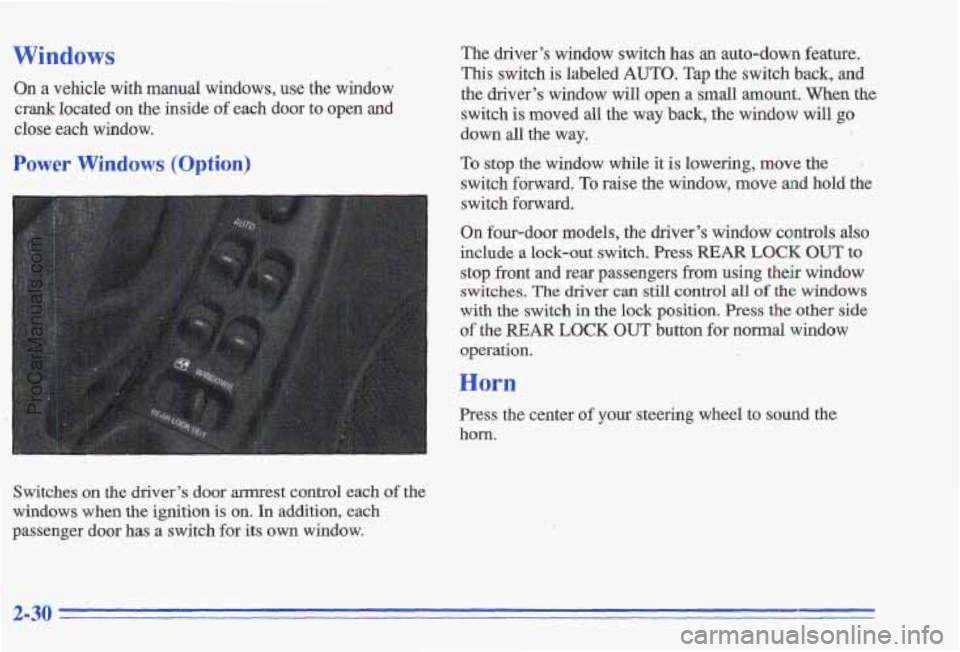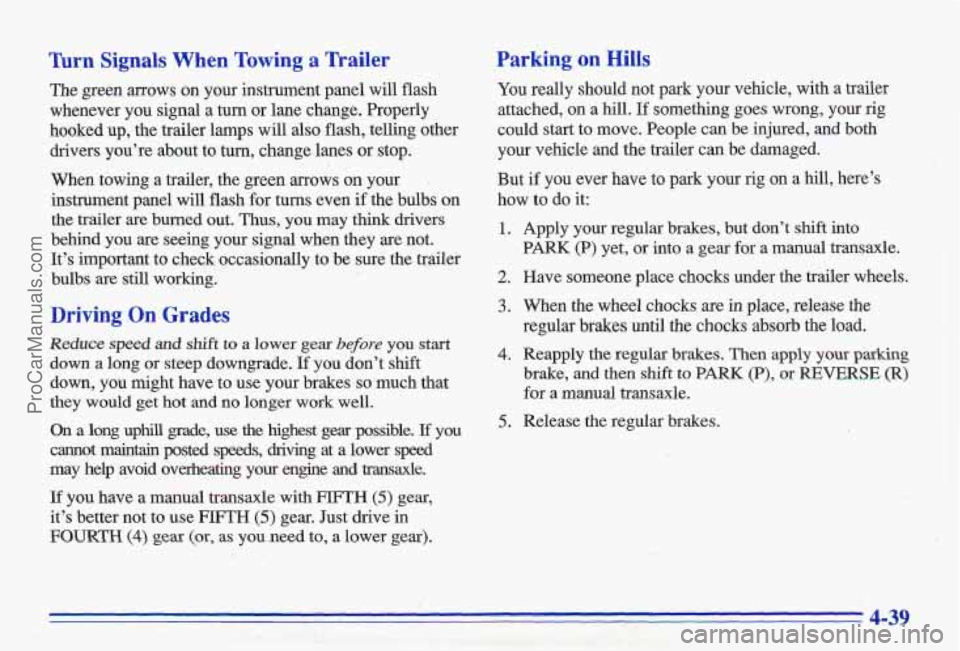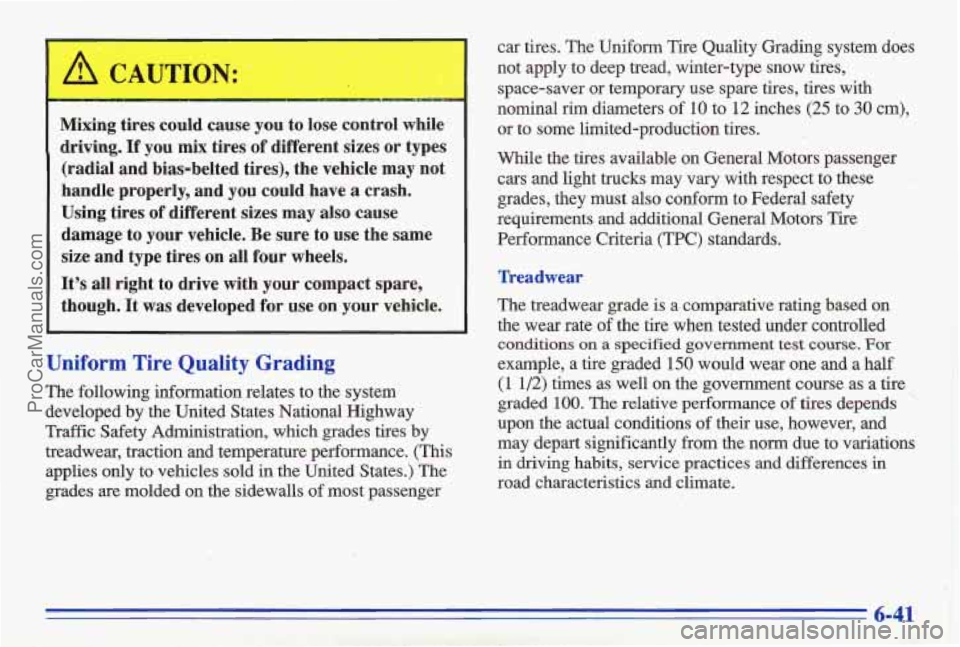Page 86 of 356

Windows
On a vehicle with manual windows, use the window
crank located on the inside of each door to open and
close each window.
Power Windows (Option)
Switches on the driver’s door armrest control each of the
windows when the ignition is on.
In addition, each
passenger door has a switch for its own window. The driver’s window switch has
an auto-down feature.
This switch
is labeled AUTO. Tap the switch back, and
the driver’s window will open a
small amount. When the
switch is moved all the way back, the window will go
down all the way.
To stop the window while it is lowering, move the .
switch forward. To raise the window, move and hold the
switch forward.
On four-door models, the driver’s window controls also
include a lock-out switch.
Press REAR LOCK OUT to
stop front and rear passengers from using their window switches.
The driver can still control all of the windows
with the switch in the lock position. Press the other side
of the
REAR LOCK OUT button for normal window
operation.
--
Horn
Press the center of your steering wheel to sound the
horn.
2-30
ProCarManuals.com
Page 178 of 356
NOTICE:
Do not tow your vehicle with the front wheels in
contact with the
ground, or the automatic
transaxle
could be damaged.
2. Set the parking brake.
3. Open the fuse panel on the driver’s side of the
instrument
panel. Remove the fuse labeled
PRNDL. This will keep your battery from
draining while towing.
wheel. See “Ignition Positions”
in the Index.
with
a clamping device designed for towing.
4. Turn the ignition key to OFF to unlock the steering
5. Clamp the steering wheel in a straight-ahead position,
6. Release the parking brake.
When you are finished towing, make sure you replace
the PRNDL fuse in the instrument panel fuse block.
If your vehicle has a manual transaxle, you may tow
your vehicle with all four wheels on the ground.
m
Follow these steps:
1. Set the parking brake. .
4-30
ProCarManuals.com
Page 187 of 356

Turn Signals When Towing a Trailer
The green arrows on your instrument panel will flash
whenever you signal a turn or lane change. Properly
hooked up, the trailer lamps
will also flash, telling other
drivers you’re about to
turn, change lanes or stop.
When towing a trailer, the green arrows
on your ’.
instrument panel will flash for turns even if the bulbs on
the trailer are burned out. Thus, you may think drivers
behind you are seeing your signal when they are not.
It’s important to check occasionally to be sure the trailer
bulbs are still working.
Driving On Grades
Reduce speed and shift to a lower gear before you start
down a long or steep downgrade. If you don’t shift
down, you might have to use your brakes
so much that
they would
get hot and no longer work well.
On a long uphill grade, use the highest gear possible. If you
cannot maintain posted speeds, driving at a lower speed
may help avoid overheating your engine and bxmsaxle.
If you have a manual transaxle with FWTH (5) gear,
it’s better not to use
FIFTH (5) gear. Just drive in
FOURTH (4) gear (or- as vou need to, a lower gear).
Parking on Hills
You really should not park your vehicle, with a trailer
attached, on a
hill. If something goes wrong, your rig
could start to move. People can be injured, and both
your vehicle and the trailer can be damaged.
But if you ever have to park your rig on a hill, here’s
how to
do it:
1.
2.
3.
4.
5.
Apply your regular brakes, but don’t shift into
PARK (P) yet, or into a gear for a manual transaxle.
Have someone place chocks under the trailer wheels. When the wheel chocks are in place, release the
regular brakes until the chocks absorb
the load.
Reapply the regular brakes. Then apply your
parking
brake, and then shift to PARK (P), or REVERSE (R)
for a manual transaxle.
Release the regular brakes.
4-39
ProCarManuals.com
Page 263 of 356

Mixing tires could cause you to lose control while
driving. If you mix tires of different sizes or types
(radial and bias-belted tires), the vehicle may not
handle properly, and you could.have
a crash.
Using tires of different sizes may also cause
damage to your vehicle. Be sure to use the same
size and type tires on all four wheels.
It's all right to drive with your compact spare,
though. It was developed for use on your vehicle.
Uniform Tire Quality Grading
The following information relates to the system
developed by the United States National Highway
Traffic Safety Administration, which grades tires by
treadwear, traction and temperature performance. (This applies only to'vehicles sold in the United States.)
The
grades are molded on the sidewalls of most passenger car tires. The Uniform Tire Quality Grading system does
not apply to deep tread, winter-type snow tires,
space-saver or temporqy use spare tires, tires with
nominal rim diameters of
10 to 12 inches (25 to 30 cm),
or to some limited-production tires.
While the tires available on General Motors passenger cars and light trucks may vary with respect to these
grades, they must also conform to Federal safety
requirements and additional General Motors Tire
Performance Criteria (TPC) standards.
Treadwear
The treadwear grade is a comparative rating based on
the wear rate
of the tire when tested under controlled
conditions on a specified government test course. For
example, a tire graded 150 would wear one and a half
(1 1/2) times as well on the government course as a tire
graded
100. The relative performance of'tires depends "
upon the actual conditions of their use, however, and
may depart significantly from the norm due to variations
in driving habits, service practices and differences in
road characteristics and climate.
ProCarManuals.com